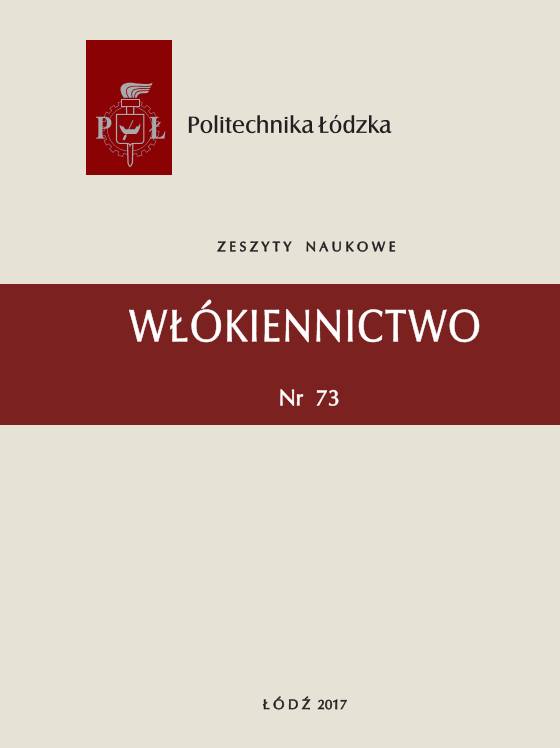Abstract
The main aim of the dissertation was to obtain cellulose fibers modified with luminescent organic and inorganic compounds for documents and papers application. The basic purpose of the research was to examine the influence of modifiers type, concentration and distribution in the polymer matrix of the fibers on their mechanical and luminescent properties, as well on the emission colour of obtained fibers. The fibers were formed with the use of dry-wet spinning method from cellulose solutions, obtained by direct dissolution of cellulose in N-methylomorpholine-N-oxide (NMMO). Luminescent modifiers were added during spinning dope preparation process. The properties of obtained luminescent fiberswere examined. The excitation and emission spectra were performed on fluorescence spectrophotometer. The characteristics of modifiers particles size and distribution in fibers matrix were studied using transmission electron microscopy (TEM). The mechanical properties of modified fibers were also determined, as well as the influence of aging tests on mechanical and luminescent properties of the fibers. Taking into account the potencial applications of obtained fibers, laboratory production paper samples were prepared containing luminescent fibers, in order to examine their behavior as an additive in papermaking process. The properties of modified paper were examined and pictures of microstructure of paper were carried out by scanning electron microscopy (SEM) analysis. As a result of my PhD thesis the fibers with special luminescent properties were prepared. Due to the method of modification the luminescent agent is closed in polymer matrix of the fibers. This provides modification’s durability and increase the fibers usability. Obtained fibers are characterized by good mechanical and luminescent properties, with different colours of emission. Aging tests of the fibers showed that estimated durability of the fibers is no less than 10 years and the mechanical properties of fibers worsens of about 40% whereas the luminescent properties are preserved. SEM analysis of paper containing luminescent fibers showed that the fibers are permanently build into the paper's structure and have no negative influence on it's properties. Addition of the fibers to the paper provides application possibilities like documents and textile protection, as well as marker for anisotropy control in papermaking process.
References
Erdman A., Kulpiński P., Grzyb T., Lis S.: Preparation of multicolor luminescent cellulose fibers containing lanthanide doped inorganic nanomaterials, Journal of Luminescence 169 (Part B), 520-527, 2015.
Kulpiński P., Erdman A., Grzyb T., Lis S.: Luminescent cellulose fibers modified with cerium fluoride doped terbium particles, Polymer Composites, Vol. 37, Issue 1, 153-160, 201
Borbely E.: Lyocell, the new generation of regenerated cellulose, Acta Polytechnica Hungarica, Vol. 5, No. 3, 2008.
Łaszkiewicz B., Kulpiński P., Niekraszewicz B., Czarnecki P., RubachaM. et al.: The method of making cellulose modified fibers, EP 1 601 824 B1, 2005.
Mangal R., Srivastava S., Archer L.A.: Phase stability and dynamics of entangled polymer – nanoparticle composites, Nature Communications, DOI: 10.1038/ncomms8198, 2015.
Klonkowski A.M., Lis S., Pietraszkiewicz M ., Hnatejko Z., Czarnobaj K ., Elbanowski M.: Luminescence properties of materials with Eu(III) complexes: Role of ligand, coligand, anion, and matrix, Chem. Mater., 15, 656, 2003.
Li L., Zhou S., Zhang S.: Investigation on charge t ransfer bands of C e4+ in Sr2CeO4 blue phosphor, Chem. Phys. Lett. 453, 283-289, 2008.
Nag A., Narayanan Kutty T.R.: Photoluminescence of Sr 2 – xLnxCeO4 + x /2 (Ln = Eu, Sm or Yb) prepared by a wet chemical method Electronic supplementary information (ESI) available: thermoanalytical, XRD and TEM studies; photoluminescence of undoped Sr2CeO4J. Mater. Chem. 13, 370-376, 2003.
Atlas Material Testing Solutions, Weathering Testing Guidebook, Atlas Electric Devices Company Pub. No. 2062/098/200/AA/03/01, 2001.
Kulpiński P.: Cellulose Fibres Modified by Hydrophobic Type Polymer, Journal of Applied Polymer Science 104, 398-409, 2007.
Ortlepp G., Beckmann E., Mieck K.P.: MelliandTextil Int. 2, 102-108, 1999.
Dilag J., Kobus H., Yu Y., Gibson C.T., Ellis A.V.: Non–toxic luminescent carbon dot/poly(dimethylacrylamide) nanocomposite reagent for latent fingermark detection synthesized via surface i nitiated reversible addi tion fragmentation chain transfer polymerization, Polymer International 64, 884-891, 2015.
Yang J., Zhang Y., Gautam S., Liu L., Dey J., Chen W., Mason R.P., Serrano C.A., Schug K.A., Tang L.: Development of aliphatic biodegradable photoluminescent polymers, PNAS, Vol. 106, No. 25, 2009.

